1c. Historians and Their Time
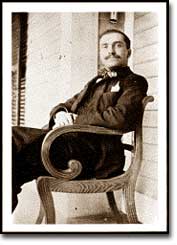
Consider these two quotes from 19th-century philosopher and poet George Santayana: "Those who cannot remember the past are condemned to repeat it." "History is always written wrong, and so always needs to be rewritten."
"On the 24th of August ... between 2 and 3 in the afternoon my mother drew his attention to a cloud of unusual size and appearance...I can best describe its shape by likening it to a pine tree. It rose into the sky on a very long "trunk" from which spread some "branches"...The sight of it made the scientist in my uncle determined to see it from closer at hand." –Pliny the Younger describing his uncle's death in the eruption of Mt. Vesuvius, 79 C.E.
There wasn't any history before 3000 B.C.E.
In a literal sense that is true. Historians mostly rely on written documents to reconstruct the past. Before 3000 B.C.E. writing did not exist, as far as we know. Accordingly, events earlier than this time are referred to as "pre-history," before written history!
Why C.E. and B.C.E.?
You may be used to seeing dates with B.C. or A.D. (for example, 2750 B.C. or A.D. 476). So why don't you see those abbreviations here?
The abbreviation B.C. stands for "Before Christ," and A.D. stands for the Latin phrase Anno Domini, which means, "the Year of Our Lord." Because history belongs to everyone, and because not everyone is a Christian, many historians have been using the new terms, B.C.E. and C.E
The abbreviation C.E. stands for the "Common Era" and is used in place of A.D. For example, 1492 C.E. is the same as A.D. 1492 (which is sometimes incorrectly written as 1492 A.D.). The abbreviation B.C.E. stands for "Before the Common Era," and is used in place of B.C. The year 1625 B.C.E is the same as 1625 B.C.
Clay and the Sumerians
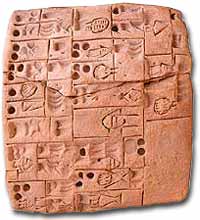
The Sumerians were among the first people to develop a written language. They recorded events and religious information on wet clay tablets using styluses. Note: This picture goes to the free New York Times website which requires registration. Ask your parent or teacher for help.
The Sumerians invented the first writing system. At first they used pictographs to represent words — little pictures drawn on wet clay. A picture of a bird represents mushen, "bird;" a fish, the word ha, "fish." Sumerian scribes quickly discovered how to write new words by joining pictures together: the signs for "woman" and "mountain" produced geme, "slave-girl" — the Sumerians took their slaves from the mountain tribes to the east. Eventually the pictures evolved into abstract patterns made by a wedge-shaped stylus. This is called cuneiform writing, from the Latin word cuneus = "wedge."
What did the Sumerians write? Mostly lists. Inventories of people and possessions, of goods to trade, of food rations for slaves. There are legal documents: marriage records, wills, contracts, deeds of sale — and tax returns by the score (one Sumerian proverb reads "You can have a lord, You can have a king, But the man to fear is the tax collector"). Of the 1500,000 clay tablets recovered so far, 75 percent deal with such matters.
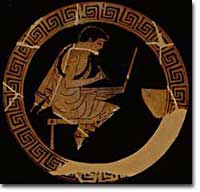
Did they have laptop computers in 480 B.C.? Hardly. The youth in this image is writing on a folded tablet using a stylus (sort of like an ancient fountain pen).
Scattered amongst them, though, are poems and epics — the world's first literature. There is a farmer's almanac, even recipes. This one comes from Akkad around 1700 B.C.E. It is for "Tuhu Beets" — beets boiled in beer (don't knock it until you've tried it), and begins: Tuhu shirum saqum izzaz me tukan lipia tanadi tusammat tabaum... Roughly, you boil beets with onions in beer, add herbs, mush everything into a porridge, then sprinkle with raw shuhutinnu . What's shuhutinnu? — "an unidentified member of the onion family."
The Sumerians never wrote history in the sense of trying to explain how the past happened, by the deed of men and women, economic factors, natural disasters or pestilence. They believed their society had been there since the universe began, planned and decreed by the gods. It never occurred to them that their land had once been scattered villages occupying desolate marshland, its greatness coming from human toil, invention, vision and determination.
Interpreting the Past
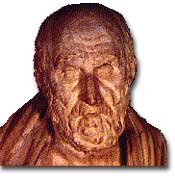
Herodotus is widely credited as being the first historian. He traveled widely in the Greek world and wrote down what he saw and the stories he heard. Herodotus coined the word history, which is Greek for "inquiries."
Credit as the First Historian goes to Herodotus, born c. 484 C.E., who lived in Athens while the Parthenon was being built. He seems to have been a trader, a compulsive story-teller, who traveled widely throughout the Greek empire. He must have made an enchanting companion, engaging in conversation everyone he met. "My business is to record what people say," he explains, "but I am no means bound to believe it." Officially he wrote an account of the war between the Persians and Greeks. Along the way he found time to be fascinated by ancient Egyptian religion, the flooding of the Nile — and gnats, on which he offers sound advice:
Everyone provides himself with a net, which during the day he uses for fishing, and at night fixes up around his bed, and creeps in under it before he goes to sleep. For anyone to sleep wrapped in a cloak or linen would be useless, for the gnats would bite through them; but they do no even attempt to get through the net.
"What made him the first serious historian," says classical scholar and poet Peter Levi, "is his combination of great scope and precise focus, his imaginative power as a story-teller and his rationalism, his concern with truth."
Vesuvius: A Case Study in History
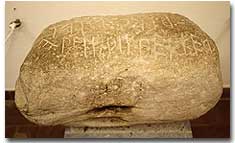
It might not look like much, but this 316-pound rock was to the ancient Greeks what the Heisman Trophy is to a collegiate football player. The inscription reveals who won the weight lifting competition in one of the first Olympics: "Bybon has lifted me over his head with one hand." Did Bybon know his victory would make for some heavy history over 26 centuries later?
In Roman times, Pliny-the-Younger proved a worthy successor with his brilliant description of the eruption of Vesuvius quoted above. He was just 17 years-old when the volcano exploded, destroying the towns of Pompeii and Herculaneum. His account has helped modern volcanologists reconstruct the event. It lasted about 18 hours, Pliny tells them. There was a cloud shaped like "a pine tree" — a dense column of hot gas, rock and ash, tossed 20 miles up into the sky. After about 12 hours, the force of the blast slackened. The column collapsed hurtling a gigantic surge cloud of hot ash down Vesuvius' western slope at 100 mph. Within 4 minutes it reached Herculaneum, blasting buildings, burning or suffocating the people. A second surge devastated Pompeii.
During the 1981 eruption of Mt. St. Helens scientists were amazed at the speed and power of these so-called "pyroclastic flows." They overturned forests and engulfed a car speeding away at 80 mph. Pliny reports one of these surges and was fortunate not have perished in it: "I look back: a dense cloud looms behind us, following us like a flood poured across the land... The fire itself actually stopped some distance away, but darkness and ashes came again, a great weight of them..." His uncle was not so lucky and died across the Gulf of Naples at Stabiae.
Vesuvius will erupt again. The only question is when. Millions of people now living in the shadow of the volcano will be at risk.
The philospher George Santayana remarked: "Those who do not remember the past are condemned to relive it." Henry Ford dismissed history as "bunk." Edward Waldo Emerson maintained "There is no history; only biography." Percy Bysshe Shelley put it poetically: "History is a cyclic poem written by Time upon the memories of man." Shakespeare is briefest: "The past is prologue." The future begins here.
Herodotus, the first historian, claimed modest goals for his work: "that the doings of men may not be forgotten." On the title page he wrote Historia, Greek for "inquiries" or "researches." Inquiring into the past has been called history ever since.







